In the immersive world of Schedule 1, the virtual casino stands as both a temptation and opportunity for players seeking to multiply their hard-earned in-game currency. Unlike many game mechanics that reward persistence or skill alone, the casino introduces an element of calculated risk that can dramatically accelerate your financial growth—or deplete your reserves just as quickly. The three distinct gambling experiences offered—Slots, Ride the Bus, and Blackjack—each present unique risk-reward profiles that appeal to different player temperaments and bankroll strategies.
While the flashing lights and promise of instant riches might lure many players through the casino’s virtual doors, understanding the mathematical underpinnings and optimal approaches to each game can transform random gambling into strategic play. This guide delves into the mechanics, strategies, and psychological aspects of Schedule 1’s casino games, equipping you with the knowledge to approach the felt with confidence rather than mere hope. Whether you’re looking to build your bankroll or simply experience all the game has to offer, mastering these casino mechanics could be your ticket to in-game prosperity.
Table of Contents
Understanding Schedule 1 Casino Games: Strategies for Maximum Profits
The virtual casino in Schedule 1 offers players three distinct gambling experiences, each with its own mathematical odds and strategic considerations. Unlike many other in-game money-making methods that provide predictable returns, casino games introduce a risk-reward element that can either multiply your wealth exponentially or deplete your resources in minutes. Understanding the nuances of each game is essential before committing your hard-earned in-game currency to the casino floor.
Blackjack emerges as the clear frontrunner among Schedule 1’s gambling options, offering the most favorable odds for disciplined players. The game follows traditional blackjack rules where the objective is to draw cards totaling as close to 21 as possible without exceeding that threshold. What makes Blackjack particularly appealing in Schedule 1 is the relatively lower house edge compared to other casino games, with proper play reducing the mathematical disadvantage to minimal levels.

Success in Blackjack requires understanding basic strategy—knowing when to hit, stand, double down, or split based on your cards and the dealer’s visible card. Players who take time to learn these fundamental decisions can transform Blackjack from a game of chance into a semi-reliable income source. The predictability factor exceeds both Slots and Ride the Bus significantly, making it the recommended starting point for players new to Schedule 1’s casino mechanics.
Ride the Bus presents a more complex gambling experience, requiring players to make consecutive correct predictions about drawn cards within a limited timeframe. The game challenges players with four sequential questions about upcoming cards: predicting color (red or black), relative value (higher or lower than the previous card), card range, and finally, the specific suit of the final draw. While Ride the Bus offers potentially higher payouts than Blackjack for successful prediction streaks, the compound probability of correctly answering all four questions makes consistent profits unlikely.
The game’s multi-stage structure creates psychological tension that some players find appealing, but from a purely mathematical perspective, the risk-reward ratio is less favorable than Blackjack. Players attracted to Ride the Bus should approach with caution, perhaps allocating only a small percentage of their gambling budget to this higher-variance game.
The Slot machines in Schedule 1 represent the highest risk option among the three casino games, with extremely low probability of significant returns. As in real-world casinos, slots offer the allure of massive jackpots (particularly with triple 7s or triple bell combinations) but compensate for these potential payouts with very low hit frequencies. The randomized nature of slot outcomes means there’s no skill element or strategy that can improve your odds—results are determined entirely by the game’s random number generator. Our analysis suggests that slots should be approached as entertainment rather than a serious money-making method within Schedule 1.

The rare jackpot win might be memorable, but over any significant playing period, slots will almost certainly diminish rather than increase your bankroll. Consider limiting slot play to small recreational amounts that you’re comfortable losing in exchange for the momentary excitement of pulling the virtual lever.
The psychological aspects of gambling apply even within Schedule 1’s virtual casino environment. Players often fall victim to common cognitive biases like the “gambler’s fallacy”—believing that previous results influence future outcomes, such as thinking a slot machine is “due” for a win after several losses. Understanding that each slot pull, card draw, or Blackjack hand represents an independent probability event can help maintain rational decision-making during your casino sessions. Setting strict loss limits before beginning play is perhaps the most important strategy across all three games. Deciding in advance the maximum amount you’re willing to lose helps prevent the “chasing losses” behavior that typically leads to depleted bankrolls.
| Game | Skill Level | House Edge | Profit Potential | Recommended Bankroll | Best Strategy |
|---|---|---|---|---|---|
| Blackjack | Medium | Low | Steady, consistent | 20-30x minimum bet | Learn basic strategy, walk away after 50% profit |
| Ride the Bus | Low-Medium | Medium | Volatile, inconsistent | 15-20x minimum bet | Focus on high-probability early questions |
| Slots | None | Very High | Extremely rare big wins | 50-100x minimum bet | Small, limited sessions for entertainment only |
For those serious about maximizing profits in Schedule 1’s casino, bankroll management represents the critical foundation of successful play. Professional gamblers typically recommend risking no more than 1-5% of your total bankroll on any single bet, allowing you to weather the inevitable losing streaks while capitalizing on winning periods. This approach is particularly important in Blackjack, where proper strategy can create extended winning sessions if you have sufficient funds to survive temporary downswings. Consider starting with a bankroll of at least 20-30 times the minimum bet for Blackjack, ensuring you can play enough hands for the mathematical probabilities to work in your favor.

The most successful Schedule 1 players often incorporate casino games into a diversified money-making strategy rather than relying solely on gambling for income. Using profits from more reliable activities like farming (particularly automated farming) or mission completions to fund periodic calculated gambling sessions represents a balanced approach. This method allows you to enjoy the excitement of casino games while limiting your exposure to their inherent variance. Remember that even with perfect play in Blackjack, short-term results can vary widely due to the random distribution of cards. Patience and discipline ultimately determine whether Schedule 1’s casino becomes a profitable venture or a financial drain on your in-game resources.
8 Best Characters for Genshin Impact Imaginarium Theater: April 2025 Meta Guide
Frequently Asked Questions
What are the exact odds and payouts for winning combinations in Schedule 1’s slot machines?
The slot machines in Schedule 1 operate with a significantly high house edge, with exact odds intentionally not disclosed by the developers to maintain the game’s mystery. Based on extensive community testing, the triple 7s jackpot appears to hit approximately once every 6,000-8,000 spins, offering a payout of roughly 5,000x your bet. Triple bells, the second-highest combination, hits more frequently at around once per 2,000 spins with a payout of approximately 1,000x your stake.
All other winning combinations occur more commonly but with substantially lower payouts ranging from 2x to 50x your bet. The overall return-to-player percentage is estimated to be between 70-80%, significantly lower than what you’d find in regulated real-world casinos, making slots in Schedule 1 primarily an entertainment feature rather than a reliable profit method.
If you’re determined to play slots despite the unfavorable odds, consider setting extremely strict loss limits (perhaps 1% of your total bankroll) and viewing any wins as fortunate exceptions rather than expected outcomes. Many experienced players recommend allocating only “entertainment money” to slots—funds you’d be equally happy spending on other non-profitable activities within the game—while directing serious money-making efforts toward Blackjack or non-casino activities altogether.
Is there a way to predict card patterns in Ride the Bus to improve winning chances?
No, there is no legitimate method to predict card patterns in Schedule 1’s Ride the Bus game, as the virtual deck is thoroughly randomized after each round using industry-standard random number generation. However, understanding probability can significantly improve your decision-making process.
For the first question (red or black), the odds are exactly 50/50 assuming a full deck. For the second question (higher or lower), your decision should be based on the value of the first card—if it’s low (2-6), guess higher; if it’s high (9-A), guess lower; if it’s middle-valued (7-8), the choice becomes more difficult with slightly shifted odds. The third question about card range becomes increasingly complex as previous cards affect the remaining deck composition. Some players report slightly improved results by mentally tracking card removal, but the time pressure in Schedule 1’s implementation makes this challenging.
For the final suit prediction, each suit has exactly a 25% probability if no cards have been removed. The most effective approach isn’t finding patterns but rather making mathematically sound choices based on the current game state and understanding that even perfect play will result in frequent losses due to the compound probability of succeeding at all four questions being quite low—approximately 6-8% for optimal play according to community testing.








